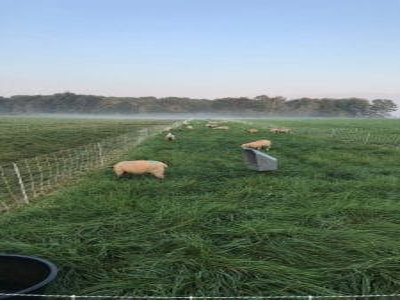By Chris Penrose
Be careful on when to start grazing: you may not want to rush it and we may need to fix it.
One goal I have had with livestock grazing over the years is to start as soon as I can. I have my spring calving cows on stockpiled grass now and they are calving on a nice sod. It is my hope that I will not have to feed them any more hay. Many years this works and some years it does not. On my farm, grass has started to grow.

If March continues like the way it is going, I suggest we don’t rush things as we have a couple issues that could be going on. First, growth is a little slow this spring, and second, many pastures have sustained abnormal damage this winter from the wet conditions we are still having. If you have fields that were not grazed in the late fall or over the winter and are in good shape, you may be able to do a fast rotation through them when growth allows it and if the animals do not cause damage to the field. However, if fields are not in good shape and with growth which has started in many parts of the state right now, if the animals graze that new growth, it will at the very least stress the plant. Waiting is a better option. Grass starts growing from the roots and needs enough leaf surface to start putting energy back into the roots and if it is grazed off before this can happen, it will weaken or kill the plant. In addition, if the field does not get enough time to recover and grow desirable grass and legumes, summer annual weeds are likely to germinate and grow in the next couple months. How many of us had weeds like foxtail, horsenettle, cocklebur, and ragweed in our fields last year? A likely contributor could be the fields were grazed too close and too soon in the spring. I have had success reducing weed issues, ragweed in particular, by skipping the first rotation or two in fields that had notable damage from feeding hay over the winter.
If you do plan on doing early grazing when growth starts with the hope that by the time that is done the spring “flush of growth” will have started, don’t keep them in paddocks too long. The fast rotation will reduce the chances that animals will graze too close, and if the ground is wet, pugging will be minimized. Also skip paddocks at least once where you fed hay this winter to allow them to recover and reduce the amount of summer weeds you will have.
If you have damage to paddocks, there are a several options: do nothing or smooth up and re-seed (it is probably too late to frost seed). If damage is not too bad, you can simply do nothing. Production may be limited for the year and you may need to monitor weed issues.
If you need to smooth up ground and re-seed, determine if you want to plant annual or perennial plants, I generally lean towards perennials. Many situations, a mix of grass and legumes works well. If it is in a field that will have abuse in future years, a persistent grass like endophyte fescue or a novel endophyte fescue will provide a denser more persistent sod.
The bottom line is the less we have to feed hay in fields, the less damage we will potentially have. In the perfect world, we would be able to stockpile enough forage and even plant some crops like turnips, oats and cereal rye to meet most of the feed requirements for the winter. When we have to feed hay, a heavy use pad is an excellent option.
Fortunately, if you have sheep and goats, damage is likely to be less than with cattle. There are a lot of variables in each producer’s operation. Everyone’s situation is a little different, but resist the temptation if hay is running short to put your animals out on fields that are just starting to grow that have been under any stress from close grazing or winter damage. It will allow for less hay fed in the long run and a more productive field this summer. If areas need to be re-seeded from damage, they will also need additional time to recover and grow as well. Finally, now is a good time to evaluate ways to reduce the need for stored feed next winter.
Source : osu.edu